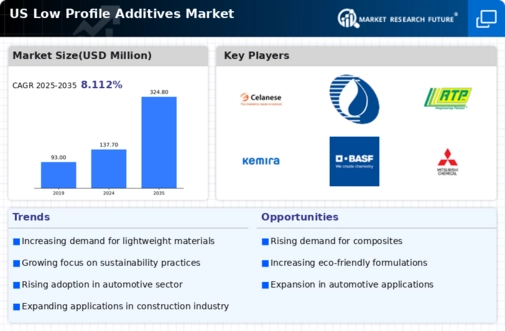The US Low Profile Additives Market has developed a robust landscape marked by significant competitive activity, characterized by a diverse array of key players striving to capture a larger market share. This competitive environment is influenced by factors such as product innovation, strategic partnerships, and geographical expansion efforts. As the demand for low profile additives continues to increase across various sectors, including automotive, construction, and consumer goods, companies are keenly focusing on enhancing their offerings to meet the nuanced needs of customers.
The ongoing technological advancements and the emphasis on sustainable practices are also driving competition, pushing firms to invest in research and development while effectively positioning themselves against each other. Additionally, fluctuating raw material prices and regulatory frameworks play crucial roles in shaping market dynamics, which, in turn, affects competition among players.Celanese is a prominent entity in the US Low Profile Additives Market, recognized for its significant contributions and extensive product portfolio. The company has carved a strong market presence through its innovative solutions that enhance the performance of composite materials.
Celanese has established itself as a leader by focusing on high-quality manufacturing processes, ensuring that its additives deliver exceptional attributes such as improved flow and reduced shrinkage in moldings. The company’s commitment to R&D has allowed it to continuously improve its products and develop new formulations that address evolving industry demands.
Celanese's strategic collaborations with other industry leaders and investment in advanced technologies have further solidified its competitive edge, enabling it to respond adeptly to market challenges and seize growth opportunities in the US landscape.Specialty Polymers has emerged as a key player in the US Low Profile Additives Market, specializing in developing high-performance polymers and additives for various applications. The company is recognized for its comprehensive suite of products designed to enhance the mechanical and aesthetic properties of composite materials.
With a consistent focus on innovation, Specialty Polymers invests heavily in R&D to refine its offerings and introduce cutting-edge solutions tailored to the specific needs of its customers. The organization is likely involved in strategic mergers and acquisitions aimed at expanding its technological capabilities and broadening its market reach within the US. By leveraging its expertise in the formulation of low profile additives, Specialty Polymers has positioned itself as a reliable partner for manufacturers seeking to improve their production processes and end-use applications.
Its strong market presence is supported by a commitment to sustainability and product excellence, resonating well with trends favoring environmentally friendly practices in the manufacturing sector.





















